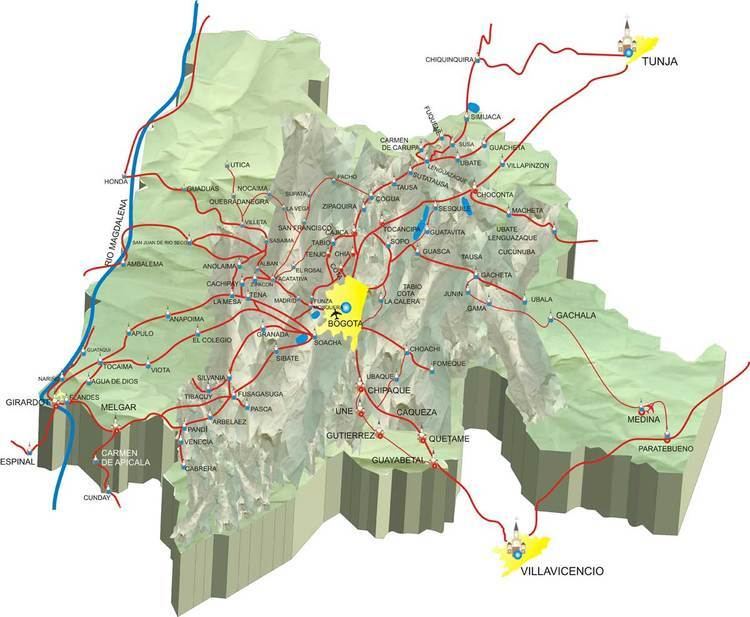Country Colombia Region Andean Region Founded June 15, 1857 Population 2,598,245 | Area 24,210 km2 Capital Bogota Governor Alvaro Cruz Vargas | |
 | ||
Colleges and Universities Universidad de La Sabana Destinations Points of interest Salt Cathedral of Zipaquira, Monserrate, Gold Museum - Bogota, Museo Botero, Lake Guatavita | ||
Map of Cundinamarca Department
Department of Cundinamarca (Departamento de Cundinamarca, [kundinaˈmaɾka]) is one of the departments of Colombia. Its area covers 22,623 square kilometres (8,735 sq mi) (not including the Capital District) and it has a population of 2,598,245 as of 2013. It was created on August 5, 1886 under the constitutional terms presented on the same year. Cundinamarca is located in the center of Colombia.
Contents
- Map of Cundinamarca Department
- Etymology
- Geography
- Municipal population position
- Important cities
- Provinces
- Sports
- References

Cundinamarca's capital city is Bogotá, the capital of Colombia. This is a special case among Colombian departments, since Bogotá is not legally a part of Cundinamarca, yet it is the only department that has its capital designated by the Constitution (if the capital were to be ever moved, it would take a constitutional reform to do so, instead of a simple ordinance passed by the Cundinamarca Assembly). In censuses, the populations for Bogotá and Cundinamarca are tabulated separately; otherwise, Cundinamarca's population would total over 10 million.
Etymology
The name of Cundinamarca comes from Kuntur marqa, an indigenous expression, probably derived from Muisca and means "condor's nest", it was used in pre-Columbian times by the natives of the Magdalena Valley to refer to the nearby highlands.
Geography
Most of Cundinamarca is on the Eastern Cordillera (Cordillera Oriental), just south of Boyacá, bordered by the Magdalena River on the west, reaching down into the Orinoco River basin on the east, and bordering on Tolima to the south. The capital district of Bogotá is nearly completely surrounded by Cundinamarca territory and was formed by carving up Cundinamarca. Because of this and other border changes, the present department of Cundinamarca is much smaller than the original state.
Municipal population position
According to the latest census conducted in 2005, 2,280,037 people live in Cundinamarca, excluding 6,776,009 of the capital, Bogotá. The racial makeup is:
The city of Bogotá and the municipalities of Soacha, La Calera, Cota, Chía, Madrid, Funza, Mosquera, Fusagasugá, Facatativá and Zipaquirá form a single metropolitan area.
Important cities
Cundinamarca is made up of 116 municipalities, six of which recorded a population of over 100,000 and could be considered as cities: Soacha, Fusagasugá, Girardot, Facatativá, Zipaquirá and Chia, while Bogotá District is in the category of capital.
Other major towns are Ubaté due to high livestock and dairy production. Guaduas, is an important cultural center. Chocontá and Fred are agricultural centers.
Provinces
Cundinamarca has 15 provinces and the Capital District (Bogotá), which simultaneously acts as capital of the Republic, capital of the Department and a separately administered District (or Department) in itself.
- Almeidas
- Upper Magdalena (Alto Magdalena)
- Lower Magdalena (Bajo Magdalena)
- Gualivá
- Guavio
- Central Magdalena (Magdalena Centro)
- Medina
- Eastern (Oriente)
- Rionegro
- Central Savanna (Sabana Centro)
- Western Savanna (Sabana Occidente)
- Soacha
- Sumapaz
- Tequendama
- Ubaté
Sports
The department is home to the basketball team Cóndores de Cundinamarca, which plays its home games in the Coliseo de la Luna in Chía.
